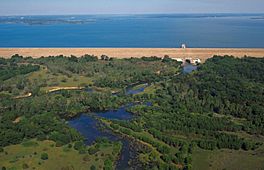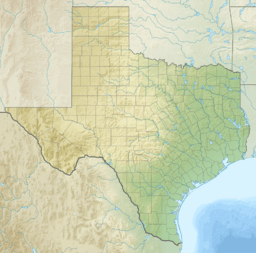Lewisville Lake facts for kids
Quick facts for kids Lewisville Lake |
|
|---|---|
| Lake Dallas (previously) | |

Aerial view of Lewisville Lake and Dam
|
|
| Location | Denton County, Texas |
| Coordinates | 33°04′09″N 96°57′52″W / 33.06917°N 96.96444°W |
| Type | reservoir |
| Primary inflows | Elm Fork of the Trinity River |
| Catchment area | 325,700 acres (1,318 km2) |
| Basin countries | United States |
| Managing agency | United States Army Corps of Engineers |
| Built | 1948 |
| First flooded | 1955 |
| Max. length | 11 mi (18 km) |
| Max. width | 4.24 mi (6.82 km) |
| Surface area | 29,592 acres (11,975 ha) |
| Max. depth | 67 ft (20 m) |
| Water volume | 555,000 acre⋅ft (685,000,000 m3) |
| Surface elevation | 522 ft (159 m) |
| Frozen | 16 February 2021 |
| Islands | has islands and islets |
| Settlements | Lewisville, Texas |
Lewisville Lake is a large reservoir (a human-made lake) in North Texas, USA. It's located on the Elm Fork of the Trinity River, close to the city of Lewisville in Denton County. This lake was first built in 1927 and was called Lake Dallas. Later, it was made much bigger in the 1940s and 1950s and renamed Lewisville Lake. Its main jobs are to help control floods and provide drinking water for Dallas and nearby towns. People also love to visit it for fun activities like boating and fishing!
Contents
The Story of Lewisville Lake
Lewisville Lake is actually the second lake built in this area on the Elm Fork of the Trinity River. The first one was called Lake Dallas. It was created in 1927 when the W.E. Callahan Construction Company finished building the Garza Dam. This project cost about $5 million.
The Garza Dam was very long, stretching for 10,890 feet (3,320 m). Lake Dallas held a lot of water, about 194,000-acre-foot (239,000,000 m3), and had forty-three miles of shoreline. For 31 years, this lake was the main source of drinking water for the city of Dallas.
Expanding the Lake
By the 1940s, people realized they needed more water storage and better flood control. So, the United States Congress passed a law in 1945 to build more structures in the Trinity River basin. The United States Army Corps of Engineers took on this big project.
They built the Garza-Little Elm Dam between 1948 and 1954. This new dam cost $23.4 million. It connected Lake Dallas with two creeks, Hickory Creek and Little Elm Creek. The huge Lewisville Dam, which is 32,888-foot (10,024 m) long, was completed in 1955.
In 1957, the old Garza Dam was broken down to create one giant new lake. This new lake was first called Garza-Little Elm Reservoir, but it was later renamed Lewisville Lake. It had a much larger shoreline of one hundred eighty-three miles and could hold 436,000-acre-foot (538,000,000 m3) of water. In 1998, the lake's water level was raised even higher, increasing its capacity to 555,000 acre-feet.
Ancient Discoveries
During the construction of the dam, workers from the Corps of Engineers found an amazing archaeological site. In 1956, scientists announced that tests on artifacts from the site showed humans might have lived there around 36,000 years ago. This included a special stone tool called a Clovis projectile point, used by early Paleo-Indians.
This discovery caused a lot of discussion among archaeologists. The water levels were too high to access the site again until 1978. From 1978 to 1980, Dennis Stanford from the Smithsonian Institution carefully studied the site. He found that the original dating was incorrect due to a rare issue. He concluded that the site was actually about 12,000 years old. Even so, it's still considered one of the earliest places where humans lived in the Southwestern United States and Mexico.
Naming the Lake
After the old Garza Dam was removed and Lake Dallas became part of the new reservoir, there was some confusion about the lake's official name. This was made even more confusing when the nearby town of Garza changed its name to Lake Dallas.
The federal government tried to rename the lake Lewisville Reservoir in 1960 but changed their minds in 1961. The confusion lasted until the mid-1970s when it was officially named Lewisville Lake. In 1991, the city of Denton added a power plant at Lewisville Dam. This plant uses the lake's water to create electricity.
The Lake Freezes Over
In February 2021, North Texas experienced a very rare and extreme cold snap. Temperatures dropped to record lows, making large parts of Lewisville Lake freeze over. Local measurements showed the ice was about 2 inches thick near the shore and even thicker closer to land. This was the first time Lewisville Lake had frozen since it was created in 1957.
Fun Activities at Lewisville Lake
Lewisville Lake is a very popular spot, especially in the summer, because it's close to the Dallas/Fort Worth Metroplex. It can get quite busy!
There are six marinas and three restaurants right on the lake. Many people enjoy boating, and you can even find businesses that offer boat tours or charters. If you're looking for a lively place, many boaters like to visit Party Cove. This spot is in the middle of the lake, near Westlake Park, where boats tie up together, play music, and socialize.
Lewisville Lake is also a great place for fishing. In 2005, a big bass fishing tournament was held here. A famous angler named Kevin VanDam won first place and $100,000! He also caught the biggest bass ever recorded in the lake at that time, weighing 11 pounds 13 ounces (5.4 kg). The Woman's Bassmaster Tour also held events here in 2005, 2006, and 2008.
Lewisville Lake Environmental Learning Area
Next to the lake is the Lewisville Lake Environmental Learning Area (LLELA). This is a huge nature preserve, covering 2,600 acres. It's a wonderful place for hiking, camping, and other outdoor activities where you can learn about nature.
Keeping the Dam Safe
The dam at Lewisville Lake has been a topic of concern because it's an older structure. It holds an estimated 180 billion gallons of water, and its parts and support system have needed attention to keep it strong. There have been some close calls, like a "sand-boil" in 2015, which caused some alarm.
To make sure the dam stays safe, the U.S. Army Corps of Engineers approved a big repair and upgrade project in 2017, costing $150 million. Work to reduce the risks of water leaking through the dam was finished in August 2021. In 2021, a four-year project also began to upgrade the spillway, which is the part of the dam that releases excess water.
Crossing the Lake
Nine different bridges cross Lewisville Lake, helping people and trains get around:
- The main bridge on Interstate 35E crosses the western part of the lake. This bridge can get very busy during rush hour. A project called 35Express is making it bigger, adding more free lanes and a special toll lane in each direction.
- Right next to the I-35E bridge is a railroad bridge. This bridge carries the DCTA's A-Train, a commuter train.
- Another busy bridge is on the eastern side of the lake, in Little Elm. It connects two parts of Farm to Market Road 720, also known as Eldorado Parkway. This bridge carries most of the traffic from communities east of the lake to the Lewisville Lake Toll Bridge.
- US 380 crosses the very northern end of the lake in two spots, each with a short bridge. To the west, it crosses the Elm Fork, which is the main river flowing into the lake. To the east, it crosses the inlet at Pecan Creek.
- The Lewisville Lake Toll Bridge opened on August 1, 2009. It's a NTTA toll bridge that connects Little Elm (via Eldorado Parkway) and Interstate 35E. It's located north of where the original Garza Dam used to be.
- Two bridges, part of a northern extension of Farm to Market Road 2499, opened in 2011. They cross the far western ends of the lake at Bryant Branch and Poindexter Branch.
- On the east side of the lake, F.M. 423 crosses the lake with a short bridge at the Stewart's Creek inlet.
- The Highland Village/Lewisville Lake Station is a stop on the DCTA A-train. This train connects downtown Denton with DART's Green Line in Carrollton.
See also
- Grapevine Lake
- Trinity River Authority




